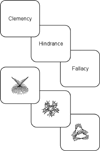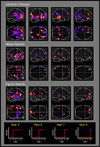II. Temporal patterns of longitudinal change in aging brain function
- PMID: 17178430
- PMCID: PMC2409150
- DOI: 10.1016/j.neurobiolaging.2006.11.011
II. Temporal patterns of longitudinal change in aging brain function
Abstract
Time-dependent changes in brain activity were assessed in a group of older adults who maintained good physical and cognitive health at years 1, 3, 5, 7, and 9 of the Baltimore Longitudinal Study of Aging neuroimaging study. Each year, these participants underwent PET scans during rest and delayed verbal and figural recognition memory conditions. While memory performance remained stable over the 8 years, both generalized and modality-specific patterns of time-dependent changes in regional cerebral blood flow (rCBF) were found. Many brain regions showed steady, progressive changes in rCBF over the 8 years while others maintained rCBF for a number of years before showing incremental declines or increases in activity. These temporal patterns of change were observed in many regions of the brain, particularly in the frontal and temporal lobes, suggesting that there are distinctive patterns of age-related functional decline and compensatory activity over time. The precise patterns of regional involvement and the temporal dynamics of rCBF change within specific regions vary based on cognitive processing demands.
Figures





Similar articles
-
I. Longitudinal changes in aging brain function.Neurobiol Aging. 2008 Apr;29(4):483-96. doi: 10.1016/j.neurobiolaging.2006.10.031. Epub 2006 Dec 20. Neurobiol Aging. 2008. PMID: 17184881 Free PMC article.
-
Effects of estrogen replacement therapy on PET cerebral blood flow and neuropsychological performance.Horm Behav. 1998 Oct;34(2):171-82. doi: 10.1006/hbeh.1998.1476. Horm Behav. 1998. PMID: 9799627 Clinical Trial.
-
Age-related changes in regional cerebral blood flow during working memory for faces.Neuroimage. 1998 Nov;8(4):409-25. doi: 10.1006/nimg.1998.0376. Neuroimage. 1998. PMID: 9811558 Clinical Trial.
-
Altered brain activity in healthy seniors: what does it mean?Prog Brain Res. 2006;157:45-56. doi: 10.1016/s0079-6123(06)57004-9. Prog Brain Res. 2006. PMID: 17167903 Review.
-
Effects of hormone replacement therapy on cognitive and brain aging.Ann N Y Acad Sci. 2001 Dec;949:203-14. doi: 10.1111/j.1749-6632.2001.tb04023.x. Ann N Y Acad Sci. 2001. PMID: 11795355 Review.
Cited by
-
Frontal Atrophy and Attention Deficits in Older Adults with a History of Elevated Depressive Symptoms.Brain Imaging Behav. 2009 Dec 1;3(4):358. doi: 10.1007/s11682-009-9078-z. Brain Imaging Behav. 2009. PMID: 20161651 Free PMC article.
-
Vascular changes and brain plasticity: a new approach to neurodegenerative diseases.Am J Neurodegener Dis. 2012;1(2):152-9. Epub 2012 Jul 23. Am J Neurodegener Dis. 2012. PMID: 23383389 Free PMC article.
-
Figural memory performance and functional magnetic resonance imaging activity across the adult lifespan.Neurobiol Aging. 2013 Jan;34(1):110-27. doi: 10.1016/j.neurobiolaging.2012.07.013. Epub 2012 Aug 15. Neurobiol Aging. 2013. PMID: 22901696 Free PMC article.
-
Changes in white matter functional networks across late adulthood.Front Aging Neurosci. 2023 Jun 30;15:1204301. doi: 10.3389/fnagi.2023.1204301. eCollection 2023. Front Aging Neurosci. 2023. PMID: 37455933 Free PMC article.
-
Quantifying Age-Related Changes in Brain and Behavior: A Longitudinal versus Cross-Sectional Approach.eNeuro. 2021 Aug 5;8(4):ENEURO.0273-21.2021. doi: 10.1523/ENEURO.0273-21.2021. Print 2021 Jul-Aug. eNeuro. 2021. PMID: 34281979 Free PMC article.
References
-
- Anderson ND, Iidaka T, Cabeza R, Kapur S, McIntosh AR, Craik FI. The effects of divided attention on encoding- and retrieval-related brain activity: A PET study of younger and older adults. J Cogn Neurosci. 2000;12:775–792. - PubMed
-
- Arnold SE, Hyman BT, Flory J, Damasio AR, Van Hoesen GW. The topographical and neuroanatomical disrtibution of neurofibrillary tangles and neuritic plaques in the cerebral cortex of patients with Alzheimer's disease. Cerebral Cortex. 1991;1:103–116. - PubMed
-
- Backman L, Almkvist O, Andersson J, Nordberg A, Winblad B, Reineck R, Langstrom B. Brain activation in young and older adults during implicit and explicit retrieval. J Cogn Neurosci. 1997;9:378–391. - PubMed
-
- Beason-Held L, Golski S, Kraut M, Esposito G, Resnick S. Brain activation during encoding and recognition of verbal and figural information in older adults. Neurobiol Aging. 2005;26:237–250. - PubMed
Publication types
MeSH terms
Grants and funding
LinkOut - more resources
Full Text Sources
Medical

